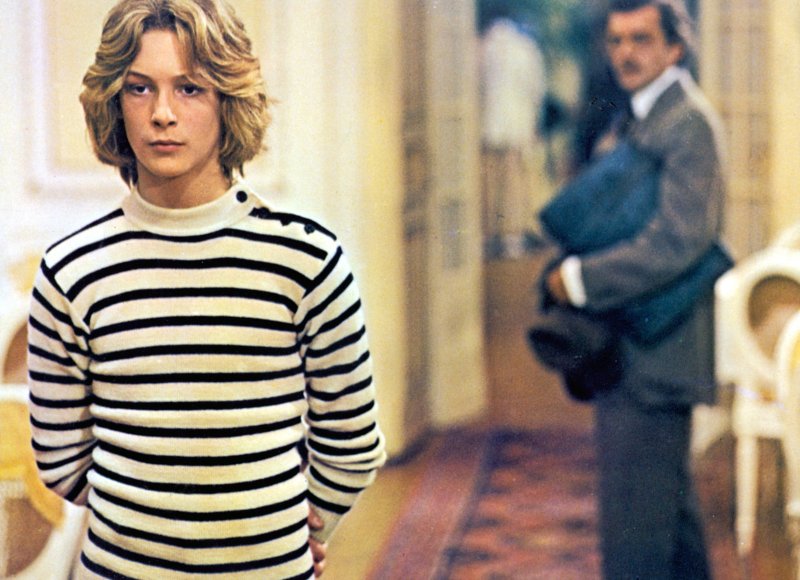Because many retirees live there, some cynics have called Florida “God’s waiting room.” In his 1971 film, director Luchino Visconti proposes another candidate for the title—Venice. Visconti’s adaptation of Thomas Mann’s novella centers around the composer Gustav von Aschenbach, who arrives in the Italian metropolis after a disastrous concert. Yet, his stay proves far from restful. At his hotel, he spies an adolescent named Tadzio. The Polish youth speaks neither English nor German, but his beautiful features can be universally appreciated. Soon, he becomes fascinated with Tadzio, and he falls madly in love. Yet, Visconti’s “Death in Venice” is not just a gay romance, but a meditation on the demise of bourgeois values.
In his review of the film, the distinguished Roger Ebert expresses the critical consensus. Visconti’s film is a “straightforward story of homosexual love” that veers toward the “vulgar and simplistic.” Some feel that the film’s depiction of homosexuality is particularly unnuanced. Aschenbach’s homosexual desires lead to his undoing. To quote Andrew Holleran’s brilliant novel “Dancer from the Dance,” Aschenbach is a “doomed queen.” He “consider[s] [himself] worthless because [he is] queer and…fall[s] into degradation and sordidness!”
Still, Aschenbach is already degraded before he meets Tadzio. His life is kitsch. He possesses pictures of his wife and children and kisses them when he goes out. He gives rambling, portentous monologues about the nature of time. The people around him don the most extravagant fashions. Their plumaged hats alone would provoke envy in any arbiter of camp. Everyone in Aschenbach’s bourgeois milieu is a “doomed queen,” but it’s not queerness that forces them into degradation and sordidness. It’s their class.
The art the bourgeoisie produce is similarly degraded. Aschenbach’s contemporaries around the turn of the 20thcentury scorned the avant-garde. Instead, they collected the works of painters like William-Adolphe Bouguereau. Bouguereau produced charming scenes of rustic villagers. His figures are all unnaturally cheerful. He often made facile allusions to other artists. For example, in his painting “The Elder Sister,” he replicates Raphael’s composition in his “Small Cowper Madonna.” By referencing Renaissance works, Bouguereau suggests that the country folk of today are just as spiritually ennobled as holy personages were in the 16th-century. Bouguereau’s clientele collected his art because it didn’t ask too much of them. They could celebrate the peasantry without worrying about their plight. They could easily grasp the connections to Renaissance masterpieces and feel enlightened.
Aschenbach would probably appreciate Bouguereau’s art. While in Venice, he flashes back to a conversation with a protégé. His student encourages him to experiment, but Aschenbach produces music that he thinks his compatriots will like. “The creation of beauty and purity is a spiritual act,” he argues. The artist “must be a model of balance and strength. He cannot be ambiguous.” Aschenbach’s music is just as balanced and as unambiguous as Bouguereau’s paintings. He may not be a good composer, but he is a successful one.
Although Visconti came from the upper echelon of Italian society, in contrast to his protagonist, he did not possess bourgeois taste. While his forebears had ruled Milan during the Renaissance, Visconti was not concerned with his heritage, just the here and now. Preoccupied with the plight of the lower classes, he joined the Italian Communist Party and became a lifelong Marxist. Enamored with the performing arts, he chose to pursue the lowly vocation of a theater and film director. These unconventional decisions allowed him to comment on his country when his compatriots could not. In his early neorealist films of the 1940s, he portrayed the poverty of the Italian peasantry so brutally that Bouguereau would flinch. He did not allude to the past so much as explore it. His 1963 film “The Leopard” is set in 1860, the year that Italy became a unified nation. He considers how political change affects an elite family not unlike his own.
Therefore, it is unsurprising that Visconti sharply critiques Aschenbach’s view of art. He voices his criticisms through Tadzio. True, Tadzio never speaks during the movie, but his very existence challenges Aschenbach. His beauty is purely physical, not spiritual. As Aschenbach becomes more and more obsessed with his visage, he ceases to be the model of balance and strength. Furthermore, his intentions toward him are ambiguous. Is this married, ostensibly heterosexual man lusting after Tadzio? Does he wish that he could be as young as Tadzio again and write better music? As he is still recovering from the death of his daughter, does he wish that Tadzio was his son?
Yet, Tadzio’s presence is consequential not only for Aschenbach, but also for every aging bourgeois in Europe. Tadzio is not a street urchin, but a Polish count. He will become part of Europe’s next generation of aristocrats. Yet, Tadzio will not simply supersede Aschenbach, but will come of age in more troubling times. While Aschenbach lives on a relatively stable continent, in his lifetime, Tadzio will witness two world wars and a catastrophic economic depression. Expensive trips to Venice will no longer be possible. After World War II, when his country is taken over by the Soviets, he will be stripped of his title and his land. Then, the entire notion of the “bourgeoisie” will fade into history.
Aschenbach is not sitting alone in God’s waiting room. He’s joined by everyone he meets in his opulent milieu. Of course, Tadzio will survive. Yet, even his classically beautiful profile will not escape unscathed. “Death in Venice” does not document the demise of a doomed queen but chronicles the end of an entire worldview.
Contact Amir Abou-Jaoude at amir2 ‘at’ stanford.edu.
